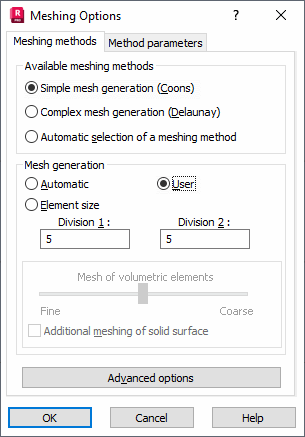Clicking Tools menu > Job Preferences (default sets of meshing parameters located in the Meshing tab) or Analysis menu > Meshing > Meshing Options, lets you select meshing methods and parameters.

Meshing methods tab
At the top of the dialog, the Allowable meshing methods field specifies a method for generating a finite element mesh:
Simple mesh generation (Coons method)
When simple mesh generation is selected, the following options are set by default:
- Available meshing methods: Coons - often, and forcing ratio: recommended
- Mesh generation: User, Division 1 =5, and Division 2 = 5
- Coons' method parameters: triangles and squares in triangular contour, and forcing ratio: proposed
- Finite elements: 4-node quadrilaterals, forcing ratio: recommended.
Complex mesh generation (Delaunay method)
When complex mesh generation is selected, the following options are set by default:
- Available meshing methods: Delaunay - often, and forcing ratio: recommended
- Mesh generation: User, Division 1 = 5, and Division 2 = 5
- Finite elements: 4-node quadrilaterals, forcing ratio: recommended
- Delaunay method parameters: Delaunay, and emitters (default and user) are selected, and smoothing is cleared.
Automatic selection of a meshing method (default setting)
When automatic mesh generation mode is selected, the following options are set by default:
- Available meshing methods: Coons - often, and forcing ratio: recommended
- Mesh generation: User, Division 1 =5, and Division 2 = 5
- Coons' method parameters: triangles and squares in triangular contour, and forcing ratio: proposed
- Finite elements: 4-node quadrilaterals, forcing ratio: recommended.
The Mesh generation field defines 3 meshing types:
- Automatic
- User - Defines two parameters of Coons' method: division1 and division2.
A division parameter for Coons' method, which defines the number of elements created on the second contour edge (between the second and the third contour vertexes). The edge of the contour is automatically divided so that the division corresponds to the first edge contour.
Note: For triangular contours: the division of the edge between the third and first contour peak is the same as between the second and third peak. In quadrilateral sections: the division between the third and fourth contour is the same as between the first and second peak; and the division between the fourth and first peak is the same as between the second and third peak. - Element size - you can define a dimension for an element in the finite element mesh to be obtained after the mesh is generated. For example, if the element dimension is 20 inches:
- Planar finite element (quadrilateral) mesh, generates a mesh of elements similar to a square, whose side is 20 inches
- Planar finite element (triangle) mesh, generates a mesh of elements similar to an equilateral triangle, whose side length is 20 inches
- Volumetric finite element mesh, generates a mesh of elements similar to a cube, whose side is 20 inches.
In addition, this field specifies the type of volumetric finite element mesh to generate: from a coarse mesh to a fine mesh. If you select Additional meshing of solid surface when generating a mesh of volumetric finite elements, a mesh on a solid surface (contour) is also generated. Note when using this option, the volumetric element mesh is finer.
Clicking Advanced options at the bottom of the Meshing methods tab opens the Advanced Meshing Options dialog.
Method parameters tab
After selecting either Simple mesh generation (Coons) or Complex mesh generation (Delaunay) another tab, Method parameters, displays in the dialog.
To generate a simple mesh using Coons' method, select one of the following panel division types on the Method parameters tab:
- Triangles in triangular contour
- Triangles and squares in triangular contour
- Triangles and trapezoids in triangular contour
- Squares in rectangular contour
- Triangles in rectangular contour.
A schematic drawing illustrates the selected division type at the bottom of the dialog.
You can also select the parameters for complex mesh generation using Delaunay's method on the Method parameters tab; Select one of the following:
- Regular mesh
- Refinement (Delaunay + Kang) - Generates the mesh near the emitters according to Kang's method and outside of these contours according to Delaunay's method.
- Smoothing.
Emitters are special nodes defined at structure points that require more precise calculations, that is, a more refined finite element mesh. Two types of emitters are available:
- Default - Automatically generated at characteristic points of panels: in the corners of panels, near openings and at support nodes. You select these options in the Advanced Meshing Options dialog.
- User - User-defined using the Emitters dialog.
Refinement of a finite element mesh using Kang's method consists in generating a wave that radiates from the emitter in toward the contour. The following refinement parameters are available in the Emitters field:
- H0: The length of the first wave.
- Q: The relationship of the next wave length (H n+1 ) to the previous wave length (H n ).
For example, if you specify the following parameters: H0=1.0, Q = 1.2, H max = 2.0, then waves of the following lengths are created: 1.0, 1.2, 1.44, 1.73, 2.07, 2.5; on the remaining part of the contour the mesh is generated according to Delaunay's method.